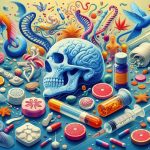What is Anemia?
Anemia
Anemia is the general name for a condition where the body either cannot make enough healthy red blood cells and/or has too little hemoglobin, the substance that enables red blood cells to transport oxygen around the body.[1]
There are many different types of anemia. These include, but are not limited to:[2][3][4][5]
- Iron deficiency anemia, the most common type of anemia
- Megaloblastic anemia, often caused by a vitamin B12 deficiency or folic acid deficiency
- Aplastic anemia, caused by damage or dysfunction in bone marrow cells
- Hemolytic anemia, caused by red blood cells being destroyed at an increased rate
Medically speaking, anemia is broadly classified as macrocytic, microcytic or normocytic, depending on the size and volume of the red blood cells (erythrocytes):[6][7]
- Macrocytic anemia. In this category of anemia, the red blood cells are larger than normal. This includes anemia caused by vitamin B12 deficiency or folate deficiency.
- Microcytic anemia. In this category of anemia, the red blood cells are smaller than normal. This includes anemia caused by iron deficiency, thalassemia or sickle cell disease.
- Normocytic anemia. In this category of anemia, the red blood cells are normal in size, but fewer than normal in number. This includes anemia caused by chronic conditions, e.g. kidney disease.
Regardless of the type or cause, common symptoms of anemia include:[8]
- Tiredness and lethargy
- Breathlessness
- Faintness
- Headaches
There may also be other symptoms specific to the type of anemia being experienced.
The treatment recommended for anemia depends on the underlying cause. In cases of iron or vitamin deficiency, treatment will typically involve dietary changes and sometimes the use of supplements or medications. In less common types of anemia, as well as severe cases, more complex approaches, such as blood transfusions, may be needed.[9][10][11]
The outlook depends on the type, cause, and severity of anemia, as well as the age and overall health of the person; but with appropriate and timely treatment, recovery or effective management can be expected in many cases.[12]
If left untreated, anemia can lead to complications, including reduced ability to function, lower quality of life, lung problems, and even heart failure.[13][12] It is important to consult a medical practitioner without delay, should the condition be suspected.
Types of anemia
There are a number of different types of anemia. These include the following:
Iron deficiency anemia
Iron deficiency anemia is caused by a lack of iron in the body, leading to reduced levels of sufficiently functioning red blood cells. Iron deficiency can be caused by a variety of factors and conditions, including internal bleeding, pregnancy, heavy menstruation, inflammatory bowel disease (IBD), and a lack of iron in one’s diet.[9]
Megaloblastic anemia
Megaloblastic anemia is a type of macrocytic anemia that can be caused by a lack of vitamin B12 or a lack of folic acid (folate). This is most often due to a dietary deficiency or malabsorption, e.g. as in pernicious anemia, where the body cannot absorb sufficient amounts of vitamin B12.[3]
Aplastic anemia
Aplastic anemia is a consequence of damage or dysfunction in the bone marrow cells, causing them to produce fewer red blood cells than needed. This may be the result of a number of conditions, including infectious diseases and autoimmune disorders, as well as certain substances and cancer treatments. Rarely, aplastic anemia may run in families. Examples of hereditary conditions that can lead to aplastic anemia include Fanconi anemia and Diamond-Blackfan anemia.[4]
Hemolytic anemia
Hemolytic anemia occurs as a result of red blood cells being destroyed more quickly than usual. This can be caused by a number of different conditions, some of which may run in families. There are many types of hemolytic anemia. Two examples include thalassemia and sickle cell anemia, both of which are hereditary.[5]
Thalassemia
Thalassemia is a genetic disorder that affects the production and function of hemoglobin, causing red blood cells to break down more easily than normal. The condition may be mild or severe.[14]
Sickle cell anemia
This is a common, severe, form of sickle cell disease – a group of conditions that cause hemoglobin to be abnormally shaped and red blood cells to break down more easily than normal. Sickle cell disease is acquired genetically.[15][16]
Read more about Sickle Cell Disease »
Concerned you or a loved one may have anemia? contact your doctor
Anemia symptoms
Common symptoms of anemia, regardless of the cause, include:[8]
- Fatigue (tiredness)
- Lethargy (lack of energy)
- Breathlessness
- Faintness
- Headaches
Less common symptoms of anemia may include:[1][17]
- Paleness
- Palpitations (the feeling that the heart is skipping a beat or pounding)
- Tinnitus (ringing in the ears)
- Muscle cramps
- Loss of appetite
- Altered sense of taste
There may also be other symptoms, depending on the type of anemia. For example, iron deficiency anemia may cause wounds to heal slowly and brittle nails. Vitamin B12 deficiency anemia may cause pins and needles, confusion, and depression.
Good to know: In the early stages of anemia, some people may not experience symptoms.[18]
People experiencing possible symptoms of anemia can use a List of Doctors to carry out a symptom assessment.
Anemia causes
There are many possible causes of anemia. These include:[9][19]
- Dietary deficiencies of essential vitamins and minerals, such as vitamin B12, folic acid and iron
- Malabsorption of nutrients, e.g. in celiac disease, Crohn’s disease
- Substantial blood loss, e.g. from heavy menstruation or inflammatory bowel disease
- Bone marrow problems and leukemia
- Certain chronic conditions, e.g. rheumatoid arthritis, kidney disease (anemia of chronic disease)
- Certain genetic disorders, e.g. thalassemia and sickle cell disease
- Certain infections, e.g. malaria
- Certain medications and therapies, e.g. some types of painkillers, antibiotics, drugs for hyperthyroidism[17] and cancer treatments[18]
- Periods where the body needs more energy than usual, such as puberty and pregnancy
Diagnosis of anemia
As the first step, a doctor will typically take the person’s medical history and perform a physical examination. They may then order blood tests to check:[19][18]
- Hemoglobin levels and red blood cell size (complete blood count)
- Vitamin B12 and folic acid levels
- Kidney function
The doctor may also ask for the following tests to be done:[19][18]
- Urine tests
- Stool (feces) tests
- A bone marrow biopsy, removing a small sample for examination
- A gastroscopy or colonoscopy to examine the digestive tract
As effective treatment of anemia depends on identifying the cause, the doctor will attempt to establish what this is. Further tests may be required if the cause is not clear.
Anemia treatment
The treatment recommended will depend on the underlying cause, as well as the severity of the anemia. Treatment may include:[19][18]
- Dietary changes to include more iron or vitamin-rich foods
- Vitamin or iron supplements
- Antibiotics, in the case of certain infections
- Hormonal medication, in some cases of heavy menstruation[20]
- Adjusting any medications or therapies that may be causing anemia
In severe or persistent cases of anemia, the following may be recommended:[19][18][21]
- Medication to stimulate the production of red blood cells or to slow down their destruction
- Medication to suppress the immune system, where this is involved[17]
- Blood transfusions
- Bone marrow transplants
- Surgery to stop internal bleeding
- Surgery to remove the spleen, where it is rapidly destroying red blood cells
Complications of anemia
If severe or left untreated, anemia can cause a number of complications, including the following:[22]
- Lasting fatigue leading to diminished productivity
- Weakened immune system
- Fast or irregular heartbeat
- Heart failure
- Problems during pregnancy, including fatigue, premature labor and problems with fetal development[23]
- Increased risk of postpartum depression
Good to know: Specific types of anemia may cause other serious complications. If any kind of anemia is suspected, it is very important to consult a medical practitioner without delay.
Prevention of anemia
While it may not be possible to prevent all types of anemia, steps can be taken to reduce the risk of developing anemia related to nutritional deficiencies. These include:[19][21]
- Eating a well-balanced diet
- Eating fortified foods and/or taking vitamin and mineral supplements where one’s diet is restrictive, e.g. vegetarians and vegans
- Avoiding regular consumption of tannin-containing tea or coffee with meatless meals, as this may interfere with absorption of iron from plant sources[24]
People experiencing symptoms that may be linked to anemia or a related condition Can search for the Nearest doctor to carry out a free symptom assessment.
Anemia FAQs
Q: Is anemia during pregnancy common?
A: Yes. Mild anemia is quite common during pregnancy, as a pregnant person needs more iron than usual.[19] It is recommended that a pregnant person eat foods that are rich in iron, such as dark green leafy vegetables, fortified cereals, eggs, nuts, and lean meats to help prevent iron deficiency anemia. A doctor may also recommend a vitamin and mineral supplement. They may order blood tests to check the person’s iron levels during pregnancy. If any symptoms of anemia are present, a pregnant person should consult a doctor without delay.[25]
For more information about achieving a balanced diet during pregnancy, see these resources on foods to eat during pregnancy and foods to avoid during pregnancy.
Q: What are the best foods for anemia?
A: It depends on the type of anemia and what is causing it. In the case of iron deficiency anemia, iron-rich foods such as dark green leafy vegetables, fortified cereals, eggs, nuts, and lean meats may be recommended to help treat the condition.[19] In the case of anemia caused by a deficiency of vitamin B12 or folic acid, other types of food may be recommended. In many cases, a well-balanced diet should provide sufficient nutrients to prevent anemia. If anemia is suspected, it is important to consult a medical practitioner, as self-diagnosis may be inaccurate.
Other names for anemia
- Anaemia (UK spelling)
- Lack of blood
- Tired blood
- Iron deficiency
-
Patient. “Vitamin B12 Deficiency and Pernicious Anaemia.” July 3, 2016. Accessed March 27, 2018. ↩ ↩
-
NHS Choices. “Iron deficiency anemia.” January 14, 2016. Accessed March 27, 2018. ↩
-
MSD Manual. “Vitamin Deficiency Anemia.” Accessed March 27, 2018. ↩ ↩
-
National Heart, Lung, and Blood Institute. “What is Aplastic Anemia?” August 22, 2012. Accessed March 27, 2018. ↩ ↩
-
National Heart, Lung, and Blood Institute. “What is Hemolytic Anemia?” March 21, 2014. Accessed March 27, 2018. ↩ ↩
-
Healthline. “Megaloblastic Anemia.” September 30, 2016. Accessed May 8, 2018. ↩
-
eMedicinehealth. “Anemia.” November 17, 2017. Accessed May 8, 2018. ↩
-
NHS Direct Wales. “Anaemia, vitamin B12 and folate deficiency.” June 20, 2016. Accessed March 27, 2018. ↩ ↩
-
Patient. “Anaemia.” November 1, 2017. Accessed March 27, 2018. ↩ ↩ ↩
-
Monthly Prescribing Reference. “Anemia: Patient Information Fact Sheet.” June, 2013. Accessed March 27, 2018. ↩
-
National Heart, Lung and Blood Institute. “Anemia.” Accessed March 27, 2018. ↩
-
Pacific Heart, Lung and Blood Institute. “Anemia.” Accessed March 27, 2018. ↩ ↩
-
Patient. “Pernicious Anaemia and B12 Deficiency.” June 24, 2016. Accessed March 27, 2018. ↩
-
Patient. “Thalassaemia.” January 22, 2018. Accessed March 29, 2018. ↩
-
National Heart, Lung, and Blood Institute. “What is Sickle Cell Disease?” Accessed March 29, 2018. ↩
-
Patient. “Sickle Cell Disease.” November 1, 2017. Accessed March 29, 2018. ↩
-
Amboss. “Anemia.” February 2, 2018. Accessed April 2, 2018. ↩ ↩ ↩
-
American Cancer Society. “Anemia in People With Cancer.” February 13, 2017. Accessed March 30, 2018. ↩ ↩ ↩ ↩ ↩ ↩
-
Better Health Channel. “Anaemia.” March, 2014. Accessed March 30, 2018. ↩ ↩ ↩ ↩ ↩ ↩ ↩ ↩
-
Hematology-Oncology Associates of CNY. “How Is Anemia Treated?” Accessed March 30, 2018. ↩
-
KidsHealth. “Anemia.” October, 2016. Accessed March 30, 2018. ↩ ↩
-
Health Service Executive. “Anaemia, iron deficiency.” Accessed April 2, 2018. ↩
-
MSD Manual: Consumer Version. “Anemia During Pregnancy.” Accessed April 9, 2018. ↩
-
Healthline. “Do Coffee and Caffeine Inhibit Iron Absorption?” October 21, 2017. Accessed May 4, 2018. ↩
-
American Society of Hematology. “Anemia and Pregnancy.” Accessed April 2, 2018. ↩
**Question: What is Anemia?**
**Answer:**
Anemia is a condition characterized by a deficiency of red blood cells or hemoglobin in the blood. This can lead to insufficient oxygen delivery to body tissues and organs, resulting in a range of symptoms.
**Types of Anemia**
There are various types of anemia, including:
* **Iron deficiency anemia:** The most common type, caused by a lack of iron in the body.
* **Vitamin B12 deficiency anemia:** Occurs when the body lacks vitamin B12, essential for red blood cell production.
* **Folate deficiency anemia:** Caused by a deficiency of folate (vitamin B9).
* **Sickle cell anemia:** An inherited condition where red blood cells become sickle-shaped and can cause pain, organ damage, and other complications.
* **Aplastic anemia:** A rare condition where the body stops producing enough blood cells.
**Causes of Anemia**
Anemia can result from various factors, such as:
* Blood loss (e.g., from trauma, heavy menstrual bleeding)
* Inadequate dietary intake of iron, B12, or folate
* Chronic diseases (e.g., cancer, kidney disease)
* Certain medications
* Genetic conditions (e.g., sickle cell anemia)
**Symptoms of Anemia**
Symptoms of anemia include:
* Fatigue and weakness
* Pale skin or mucous membranes
* Shortness of breath
* Dizziness or lightheadedness
* Rapid heart rate
* Cold hands and feet
* Brittle nails
* Restless legs syndrome
**Diagnosis of Anemia**
Anemia is typically diagnosed through a blood test that measures red blood cell count, hemoglobin levels, and other factors. The specific type of anemia can be determined based on the test results and underlying symptoms.
**Treatment of Anemia**
Treatment for anemia depends on the underlying cause and type of anemia:
* **Iron deficiency anemia:** Supplementation with iron tablets or iron-rich foods.
* **Vitamin B12 deficiency anemia:** Vitamin B12 injections or supplements.
* **Folate deficiency anemia:** Folate supplements or a diet rich in folate.
* **Sickle cell anemia:** Blood transfusions, hydroxyurea medication, and stem cell transplantation in severe cases.
* **Aplastic anemia:** Blood transfusions, growth factors, or stem cell transplantation.
**Prevention of Anemia**
Preventing anemia involves:
* Consuming a healthy diet rich in iron, B12, and folate
* Avoiding excessive blood loss
* Managing underlying medical conditions
* Consulting a healthcare professional about anemia risk factors








Anemia: Symptoms, Causes, Treatment & Diagnosis | QC Kinetix